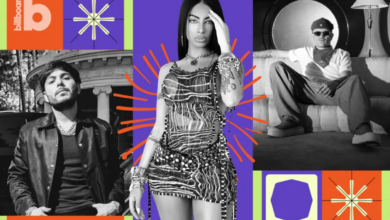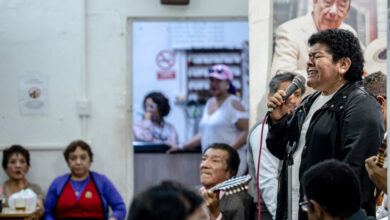The Resurgence of Tropical Music in Latin American Pop

Tropical music genres like salsa, merengue, and bachata are experiencing a resurgence among Latin pop artists such as Camilo, Fonseca, Mau y Ricky, Kany García, and Manuel Turizo, while traditional artists call for more support and investment.
Tropical music, encompassing vibrant genres like salsa, merengue, and bachata, is making a notable comeback in Latin pop. Famous artists such as Camilo, Fonseca, Mau y Ricky, Kany García, and Manuel Turizo embrace these classic rhythms, breathing new life into them with contemporary influences. However, traditional artists who have dedicated their careers to these genres emphasize the need for more significant financial backing and support to sustain this resurgence.
Prominent figures in the tropical music scene have voiced their concerns about the sustainability of this resurgence without substantial investment. Puerto Rican singer La India, recently honored by Billboard as a pioneering woman in music, stressed the importance of financial backing. “Money and support. That’s all needed for a true revival of tropical music,” she said. La India’s sentiments are echoed by other stars like Cuban singer Aymée Nuviola and Puerto Rican-American singer Luis Figueroa, as well as merengue and salsa legends such as Proyecto Uno, Tito Nieves and Gilberto Santa Rosa.
Despite the recognition and occasional resurgence in popularity, these artists argue that streaming platforms and radio stations often neglect new tropical music, opting instead to replay older hits. Nuviola pointed out, “There are playlists and even stations dedicated to tropical music, but they only play the same songs that were popular years ago. Nothing new.”
Renowned producer Sergio George, who has been influential in the tropical music industry for over two decades, shares this concern. He believes the genre’s survival depends on introducing fresh talent and engaging the younger audience. George is working on a salsa album featuring urban artists, highlighting the potential for crossover appeal. “All these young artists grew up listening to salsa, and it’s the music that touches their hearts,” he said.
Embracing a Tropical Revival
Interestingly, the current trend of pop and urban artists incorporating tropical sounds into their music is a positive development. Gilberto Santa Rosa, who collaborated on Fonseca’s recent album ‘Tropicalia,’ welcomes this blend of genres. “I love it when artists from all genres approach us, as long as it’s done with respect,” he said. This fusion broadens the audience for tropical music and keeps the genre relevant in an ever-evolving music industry.
Afo Verde, Sony Music’s President and CEO for Latin America, Spain, and Portugal, describes this shift as a natural progression following the saturation of reggaeton. “When artists started looking for alternatives, they just had to look at the rich musical heritage around them in Latin America, one of the most culturally versatile regions in the world,” Verde explained. This exploration has led to the rise of regional Mexican music and the resurgence of tropical sounds.
The pandemic also played a role in this musical shift. Many Latin artists spent extended periods with their families, reconnecting with traditional sounds. Venezuelan duo Mau y Ricky explored their roots in their new album ‘Hotel Caracas,’ which features sounds from 1980s Venezuelan music. Their single ‘Espectacular,’ a classic merengue collaboration with Dominican group Los Ilegales, reflects this nostalgic yet innovative approach. Ricky Montaner explained, “It’s the music of the parties when we were little.”
Camilo, who recently released an all-tropical album titled ‘De Adentro Pa Afuera,’ also felt a pull towards these traditional rhythms. “It was what my spirit was asking for,” he told EFE. His album explores various tropical genres, including pambiche, son, bolero, and salsa, showcasing his versatility and respect for these enduring styles.
The Need for Recognition and Investment
Despite these collaborations’ excitement, traditional artists like Tito Nieves stress the need for more recognition and support for new artists dedicated to tropical music. During a time when Manuel Turizo’s ‘La Bachata’ and ‘El Merengue’ dominated the charts, Nieves highlighted the importance of nurturing emerging talent. “It’s wonderful that young people are approaching these more classical genres. Everyone is welcome—the urban artists, the pop artists—but let’s also pay attention to the new artists who have dedicated their bodies and souls to this music,” he urged.
The call for investment is about financial backing and creating opportunities for these artists to shine on streaming platforms, radio, and live performances. Integrating tropical music into mainstream pop and urban genres should go hand in hand with supporting the artists who have kept these genres alive for decades.
Sergio George predicts that a woman will be the next major tropical music star, citing better sponsorship opportunities. “Women have more options for securing brand sponsorships and other support,” he noted. This prediction aligns with the industry’s ongoing efforts to promote diversity and inclusivity.
A Cultural Reawakening in Latin America
The resurgence of tropical music is part of a broader cultural reawakening in Latin America. Countries like Colombia, the Dominican Republic, Puerto Rico, and Venezuela have musical traditions that have influenced global music trends for decades. The renewed interest in tropical genres is a testament to the region’s vibrant cultural heritage and ability to adapt and evolve.
In Colombia, the rise of artists like Camilo and Manuel Turizo, who seamlessly blend tropical sounds with contemporary pop and urban elements, highlights the country’s dynamic music scene. Similarly, the enduring popularity of merengue and bachata in the Dominican Republic reflects the deep-rooted connection between these genres and the nation’s identity.
Puerto Rico’s contribution to the resurgence of tropical music must be considered. Artists like La India and Luis Figueroa continue championing salsa and other tropical genres, ensuring these styles remain relevant in a rapidly changing music landscape. The island’s rich musical history, from the golden age of salsa to the modern reggaeton movement, underscores its role as a cultural powerhouse.
Venezuela, too, has seen a renewed interest in its traditional music, with artists like Mau and Ricky drawing inspiration from their roots. This resurgence reflects the country’s diverse musical heritage, which includes joropo, gaita, and Afro-Venezuelan rhythms.
A Harmonious Blend of Tradition and Modernity
The resurgence of tropical music in Latin pop is a harmonious blend of tradition and modernity. As contemporary artists embrace salsa, merengue, and bachata, they pay homage to Latin America’s rich cultural heritage while introducing these genres to new audiences. This fusion revitalizes traditional music and enriches the broader musical landscape.
The renewed interest in tropical music is a welcome development for traditional artists, but it comes with a plea for more support and investment. Ensuring the sustainability of this resurgence requires a commitment to nurturing emerging talent and providing platforms for these artists to thrive.
As Latin America continues to celebrate its musical diversity, the fusion of tropical and contemporary sounds reminds us of the region’s enduring cultural influence. From the bustling streets of Bogotá to the vibrant nightlife of San Juan, tropical music remains a vital part of the Latin American experience, connecting generations and transcending borders.
Also read: Maná’s ‘México Lindo y Querido Tour’ Culminates in Homecoming
The revival of tropical music is not just a trend but a testament to the timeless appeal of these genres. With continued support and investment, tropical music will flourish, offering a rhythmic heartbeat to the rich tapestry of Latin American culture.




